Visual Disinformation and HIV-AIDS in the 1980s: The Cases of the Soviet Union and the Two Germanies
Maria Zhukova is a member of The Centre for Cultural Inquiry (ZKF) at the University of Konstanz.
In this blog, I want to show not only that disinformation has a history, but that this history has complex visual and intertextual dimensions which are of profound significance to how we analyse disinformation today. To demonstrate this, I will use the case of the disinformation campaign around the origins of the AIDS virus. The fact of the organisation and implementation by the KGB and Stasi in the Soviet Union and East Germany, respectively, of a disinformation campaign about the laboratory origin of the AIDS virus, is today beyond doubt. The Soviet and East German special services worked together, aiming to fabricate the image of a militaristic, aggressive political opponent in the face of the United States, while the main target group were residents of both East and West Germany, who received a full package of masterfully fabricated information about deadly biological weapons from Pentagon laboratories, threatening the whole world.
The existing research on this disinformation campaign is largely focused on the processes of production and transmission of textual messages, as well as the campaign’s strategic organisation and its key actors. At the same time, the role of verbal-visual constructions of certain information blocks, that is, multi-modal discourses, without which it is difficult to imagine the modern information space, remains practically beyond the limits of research attention to this day. To demonstrate the relevance of this issue, I will focus on two examples related to a common theme in the KGB-Stasi campaign: a cartoon from the newspaper Pravda for October 31, 1986[i], and the cover of the book Jacob Segal/Lilli Segal, AIDS - Die Spur führt ins Pentagon (Essen: Neuer Weg, 1990). This article studies graphical representations of the militarization of the AIDS virus, which was shaped in the Soviet and East German settings by different historical contexts and different target audiences. I will preface the analysis with a brief discussion of the history of the issue, which will simultaneously emphasize the importance of artistic, aesthetic and media components in creating an information message.
To begin with, it should be noted that agents of disinformation campaigns, as a rule, are only minimally creative in the sphere of meaning production. The first mass media reports on the artificial origin of the virus date back to 1982 and appeared in the American gay community, in particular, on the pages of the Boston newspaper Gay Community News (July 9, 1983). It is likely that these sources, which in turn relied on the opinions of American and English doctors, as well as verifiable mainstream US press reports about earlier CIA-run biological weapons programs[ii] and right-wing and conspiracy-promoting US periodicals, provided a further source for Soviet and East German disinformers. The scientific mainstream was of the opinion that the immunodeficiency syndrome (AIDS), first recorded in the United States in 1979 and given the designation Human Immunodeficiency Virus (HIV) in 1983, was imported to America, and then to Europe, from the African continent and passed to humans from the so-called green monkey (Chlorocebus sabaeus). The allegation that the virus was the fruit of a laboratory experiment, appearing as a result of gene manipulation, most likely on the instructions of the Pentagon and most likely in Fort Detrick - either to destroy homosexuals on the grounds that they were objectionable to American society, or to wage biological war with the Soviet Union –began to appear alongside other facts in the press, fiction and on German television, including in the Federal Republic of Germany, since the beginning of 1987.
A sensation for the West German reader was an interview with the East German dissident writer Stefan Heym (1913-2001), familiar in the West primarily from numerous appearances on West German television channels, with Jacob Segal, a native of St. Petersburg, Soviet citizen, and founder of the Institute of General Biology of Humboldt University in East Berlin, in the daily left-liberal West German taz (Die Tageszeitung) newspaper on February 18, 1987 under the intriguing headline "Aids - man-made in USA". An anti-fascist scientist of Jewish origin who lived in Konigsberg before World War II, Segal became a member of the German Communist Party in the 1930s, and was a member of the French resistance during World War II. Settling in the GDR after the war, Segal became one of the key figures in the joint project of the KGB and the Stasi, sympathizing with, and seemingly wanting to provide all possible support to, the forces that defeated fascism. It is quite possible that Jacob Segal, an advocate of the artificial origin of AIDS and a reputable microbiologist, sincerely believed in the conspiracy project which he helped creating and promoted in the mass media. The scientist did not change his views until his death in 1995, by which time the KGB-Stasi disinformation campaign had long come to an end due to the collapse of the USSR in 1991 and the formation of a united Germany in 1990.
The scientific style of the interview, which contains concepts from special fields, primarily virology and epidemiology, contrasts with the interspersed illustrations referring to the field of aesthetics. The photographs documenting the museum exhibits of the 18th century depicting the frightening consequences of various diseases (Fig.1-2) are borrowed from the art album "Wax figures from the museum of the Florentine Institute of Pathology" (Le Cere del Museo dell' Istituto Fiorentino di Anatomia Patologica, Giancarlo Zampi, et al. Firenze: Arnaud, 1983) and have nothing to do with the AIDS virus, about which nothing was known at that time. The taz article uses the concept of "bewußte Fehlinformation" (intentional misinformation): this is how Segal defines the theory of the origin of AIDS from green monkeys which, until this interview, had been commonplace.
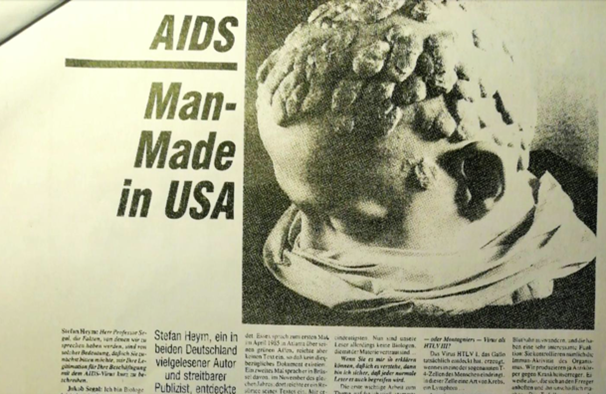
Fig.1. taz, 18.02.1987
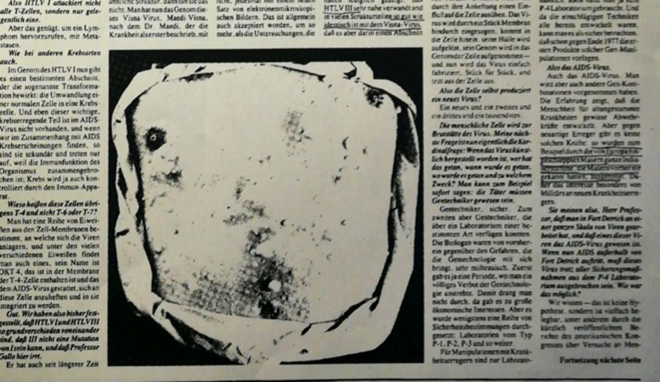
Fig.2. taz, 18.02.1987
In the same year, 1987, the topic would be picked up in the literary field. The writer (and chemical engineer by education) Johannes Mario Simmel (1924-2009) from Vienna, whose combined circulation in 1990 amounted to 80 million copies, published the best-selling novel Doch mit den Clowns kamen die Tränen (München: Knauer, 1987), the first among the West German magazine Spiegel’s bestsellers in 1987-1988[iii], in which the topic of the artificial origin of viruses is central to the plot. The taz interview between Heym and Segal, a recent news at the time, became the subject of discussion within the novel, where a sympathetic female character, a journalist named Norma, recounted the laboratory theory of "the highly qualified biologist and immunologist Segal" (pp.110-111), drawing a picture of the avalanche-like spread of AIDS in Germany.
The film "AIDS - Afrikalegende" by Heimo Claasen and Malte Rauch, produced by WDR WELTWEIT – a documentary programme run by the West German public broadcaster WDR – with the funding from both the FRG and the GDR, was shown three times during 1988-89 on West German TV channels WDR (Westdeutscher Rundfunk, regional program of the federal state of Nordrhein-Westfalen), HR (Hessischer Rundfunk), and SWR (Südwestfunk). One of the main characters is the same microbiologist with Soviet citizenship, anti-fascist Jacob Segal and his wife and colleague Lily, and from 17:49:00, there is also a narrative of experiments on people, which recalls medical experiments on people by the SS (“medizinische Menschenversuche der SS”). The Segals affirm that the theory of the origin of the AIDS virus from monkeys is anti-scientific and present their own version - the laboratory invention of the disease at the Pentagon (from 30:00:00). The film repeatedly refers to current newspaper publications, primarily, headlines with attention-grabbing illustrations embedding AIDS in the well–etched iconographic discourse with apocalyptic symbols - a human skeleton with a scythe (iconography of medieval death dances) or a giant fish named AIDS swallowing microscopic people (iconography of the biblical Leviathan) (Fig. 3-4) which, as in the case of the publication in taz, it is not very consistent with the style of the film, which claims to be scientific and was made on the basis of numerous interviews with scientists from different countries.
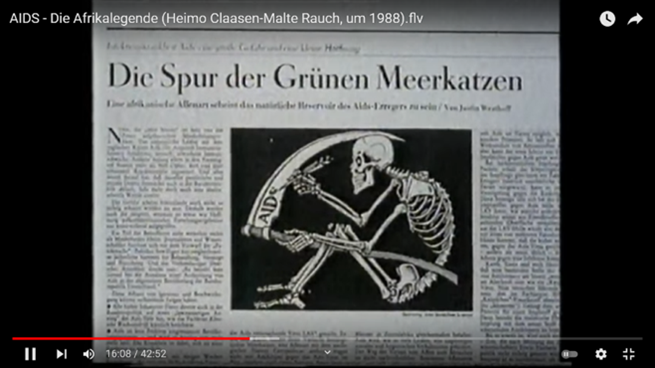
Fig. 3. 00:16:14. Headline: The Trail of the Green Monkey
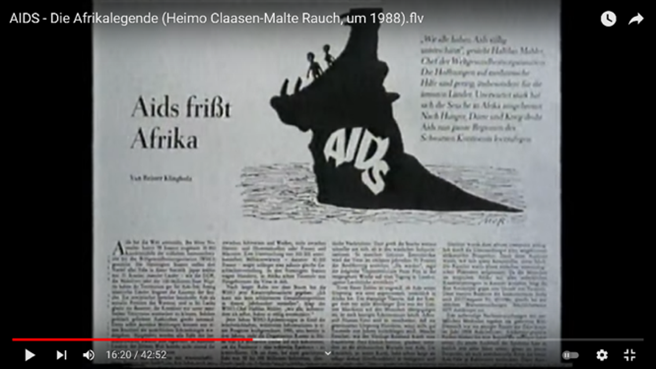
Fig. 4. 00:16:21. Headline: AIDS Devours Africa
Finally, in 1990, a study by the Segals called AIDS - die Spur führt ins Pentagon (AIDS - the trail leads to the Pentagon) was published in full in the Essen publishing house Neuer Weg[iv], along with material by another scientist Manuel Kiper called Biokrieg (A Biological War). The book was published in a small format as a paperback in a garish yellow and green cover, its yellow component appealing to the sense of danger (cf. for example, the biohazard triangle). I will focus on the cover illustration in more detail below, but for now I would like to note that these old mechanisms continued to work even after the rapid change in the political situation, the fall of the Berlin Wall in 1989 and the end of the Cold War.
The same trend is evident in the development of the Soviet disinformation campaign, which was likely launched back in the early 1980s, while its implementation fell at a completely different historical stage - the times of perestroika and glasnost, when relations between the Soviet Union and the USA improved both at the highest level - it is worth at least recalling the famous Leningrad-Seattle Soviet Space Bridge in December 1985, which became the "emblem of the new American-Soviet friendship".
In the spirit of the time, when "reading was more interesting than living," numerous print publications, both central newspapers (Pravda and Izvestiya) and specialized weeklies, including the famous Literaturnaya gazeta, the primary audience of which was the intelligentsia, became the main media of the disinformation campaign in the USSR. It was here, on the eve of the glasnost campaign, that on October 30, 1985, the article "Panic in the West, or what lies behind the sensation around AIDS" was published by Gosteleradio’s West Berlin correspondent, Valentin Zapevalov, who, in turn, with reference to the publication of July 16, 1983 in the Indian newspaper Patriot, first informed Soviet citizens that the virus was the result of "Washington's inhumane experiments" in the production of biological weapons.[v] In contrast to the West German taz, the series of illustrations in this first publication is extremely realistic: the photographs do not depict museum wax effigies affected by outlandish diseases, but real people who have fallen victim to AIDS (Fig. 5).
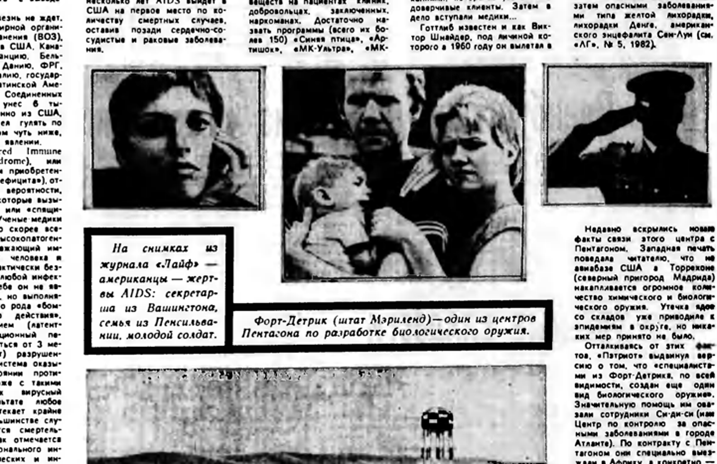
Fig. 5 Literaturnaya gazeta, 30.10.1985
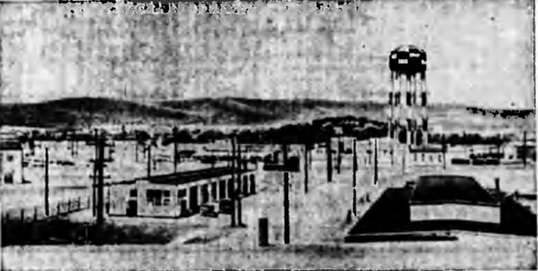
Fig. 6 Literaturnaya gazeta, 30.10.1985
The illustrations’ captions increase the story’s credibility through the specificity of the details given, including profession and place of residence. A secretary from Washington, a family from Pennsylvania, a young soldier, outwardly do not differ from the Soviet reader, who unconsciously associates themself with the depicted heroes, also afraid of becoming a victim of the sinister Fort Detrick, mercilessly infecting ordinary and innocent people with laboratory mutations. A general view of Fort Detrick, shown in the lower photo (Fig. 6), is less associated with the topic of high-tech gene manipulation aimed at creating biological weapons, but rather resembles photographs of barracks in German concentration camps, appealing to the collective memory of World War II and Nazi experiments on people.
The discussion around the laboratory origin of the virus in Literaturnaya gazeta lasted for more than a year (with articles by Drozdov, Kolesnichenko, etc.), while in the field of artistic creativity this topic was picked up by Johannes Simmel's political thriller translated into Russian by that time, published under the title "The Clowns are Gone, Tears have Come" translated by Evgeny Faktorovich (Moscow: LG-bestseller; Nasha kampaniia, 1993; republished Moskva: Mir, 2003), which to this day has not lost popularity with the reading public. In turn, the niche of the tabloid press was covered by the SPID-Info (AIDS-Info) newspaper, founded, for educational purposes, in the USSR in September 1989. The publication was characterized by a distinctly erotic orientation and a visual range exciting and interesting for the still poorly informed Soviet reader.
Echoed in various media, the news story expands its range of influence among the broad reading public and gains trust through repeated repetition and replication in new semantic blocks and media resources.
As is obvious from the material presented, in Soviet and German (both in the GDR and the FRG) discourses on the artificial origin of the AIDS virus, graphic means act as one of the effective ways to attract the recipient's attention and emotional response. In addition, the visual series contributes to the introduction of key material into other narratives that already exist and are well understood by recipients, such as, for example, the narrative of the arms race and the secret development of biological weapons, among other things, which took place during the Cold War on both sides of the Iron Curtain. The iconography of the images in question (the caricature from Pravda and the cover of the Segals’ book) reveals, however, different context-specific realizations of this narrative. The smallest, correctly selected iconographic detail becomes a trigger for collective memory, prompting additional emotionality generated by memories of a tragic past.
The Soviet cartoonist Dzhangir Agayev worked in this vein. His cartoon, published on the pages of Pravda (10/16/1986), presents AIDS virus particles in the form of Nazi crosses, handed over by the developers of the Pentagon laboratories to the military in a giant medical flask (Fig.7). The Nazi swastika is associated by Soviet readers with the Nazi threat of World War II, which claimed the lives of millions of Soviet citizens, and which affected virtually every Soviet family. The theme of the German threat (supplemented by the soldier’s cartoonishly large, hooked nose, which also corresponds to the iconography of the Nazi invaders on the poster graphics of the 1940s), is relativized using another well-readable sign – the US dollar, which is clearly distinguishable on a pack of bills received from the military by the developer of the virus. Against the background of caricatured figures, the elements of another system (signs) located in the centre and in close proximity to each other merge/coalesce, collectively acting as carriers of the threat of the entire Western world (both European and North American), driven by greed and mired in endless wars. The dozen naked human limbs in the foreground of the cartoon are also can be read primarily as a sign symbolizing the consequences of Nazi crimes. This iconography refers not so much to the topos of the morgue (bare feet sticking out from under the covered body), as to photographs from Nazi concentration camps, well known to the Soviet recipient, for example, from the documentary film "Ordinary Fascism" (1965) by Mikhail Romm (Fig.8).
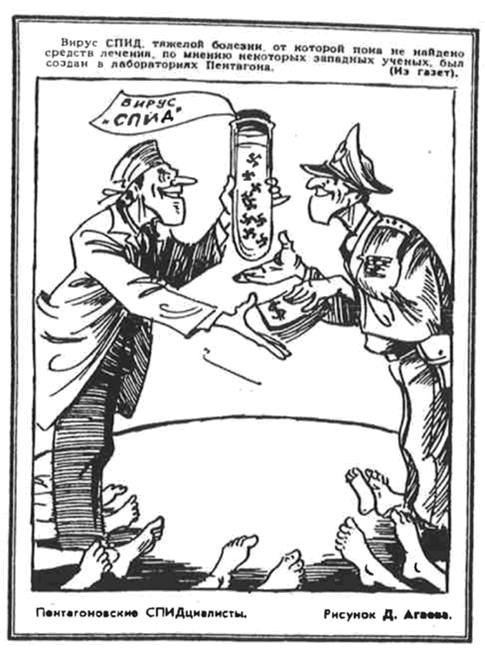
Fig. 7. Pravda,16.10.86
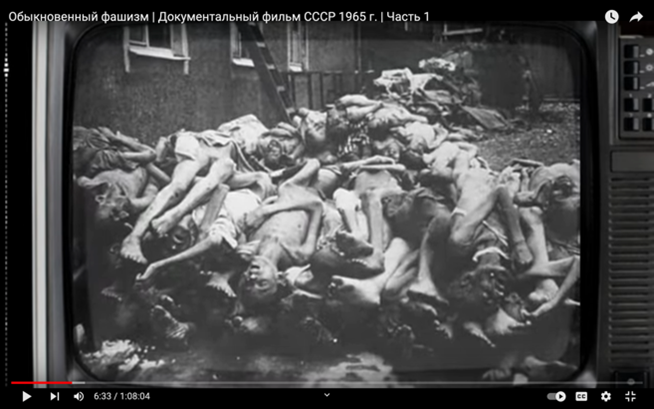
Fig. 8. M. Romm, frame from the film ‘Ordinary Fascism’
The East German artist who designed the title page of Segal's research turns to other graphic symbols when visualizing the same topic. He equips the US soldier, attacking the unarmed reader, with a DNA chain instead of a machine gun (Fig.9). The decoding of the human DNA molecule in 1953 was a breakthrough in biology, but at the same time it became one of the starting points for various kinds of experiments not necessarily conducted for peaceful purposes. Segal talks about one of these experiments in his book, supporting the claim of the laboratory origin of the AIDS virus by referencing the gene manipulation of the leukemia virus (T-Zellen-Leukemia-Virus Type I, abbreviated: HTLV-I) with the Maedi-Visna-Virus, which affects sheep. Devoid of a tangible beginning and end, DNA simultaneously resembles a giant drill bit, penetrating into the space of the image itself.
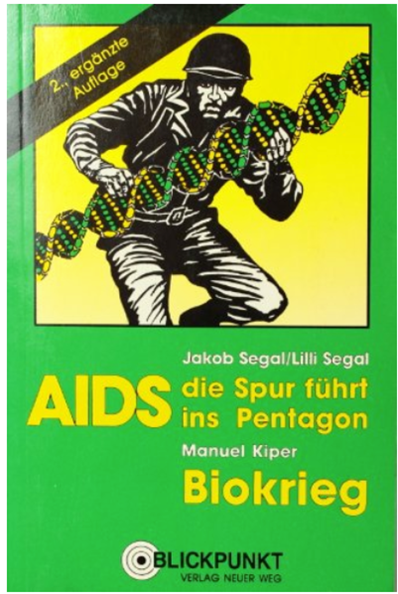
Fig. 9. Segals’ book, 1990.
The different national affiliation of the drawings and the completely different symbolic series do not prevent the authors from turning to the same artistic technique: the virus, invisible to the eye, is hyperbolized in both illustrations. The macro image makes the invisible visible by depicting the danger in such a way that it takes on the shape of other, already well-known threats.
It is characteristic that both images, operating with symbols and signs, simultaneously interact actively with the accompanying text. The comic caption under the cartoon “Pentagonovskie SPIDtsialisty" (Pentagon AIDS Specialists) is based on neologism and wordplay with a similar sound.[vi] In addition, the theme of the USA and the two-part structure with the morpheme ‘-alists’ recalls the Soviet newspaper cliché of "American imperialists", again contributing to the introduction of new material into well-established discourses[vii]. The German example is also characterized by dense visual-verbal interaction. The subtitle of Segal's book "Die Spur führt ins Pentagon" (The trail leads to the Pentagon), located under the illustration, echoes its iconography: the conventionally depicted DNA chain acts not only as a symbol of threat, but at the same time as a visualization of the theme of a path, the titular ‘trail’. According to the theory of composition used in fine art, it is the diagonal drawn from the lower left corner of the painting to the upper right (the same orientation of the DNA in the figure) that has the property of lightness and is called a "major" or strong diagonal, allowing ‘entry’ into the picture. The image is also dynamized by the figure of a military man, captured in a half-crouch and ready for a decisive strike. Thus, the DNA diagonal (visually supported by a parallel diagonal ‘2. ergänzte Auflage’, indicating the work is a ‘second, expanded edition’), along with the semantic connotation of biological weapons, acts simultaneously as a mechanism for activating reception, involving the reader in the book’s message.
It turns out that the images urge both Soviet and German readers to consider the new disease as part of the Pentagon's militaristic activities. However, if the German iconography has a connotation of a futurological forecast and fantastic hyperbole, then the Soviet iconography actualizes, above all, the narrative of the Second World War, the Fascist threat and Nazi experiments on prisoners; into which the theme of the AIDS virus is embedded, appearing in the illustration only verbally – in the form of an inscription on a tag.
The example given does not mean that the appeal to archaic visual contexts is a distinctive feature of the Soviet press. An example from the West German taz dated February 18th, 1987, shows that this is instead a transnational phenomenon. On the page with the title "Man-made in the USA" (p. 11) there is a male head affected by psoriasis (pp. 96-97 of the album); on the next page there is a male torso with symptoms of ‘molluscum contagiosum’ (pp. 104-105); on the last page there is a female profile with signs of skin tuberculosis (pp. 138-139 of the album). The chosen visual series is an attempt to create a frightening and disgusting visual background that creates parallels not with the virus itself and the disease it causes (the article does not mention the course of the disease), but with the insidious and secret laboratory experiments of the Americans, which marked the beginning of a new disaster for all mankind.
For the left-liberal and critical taz, founded in 1978 and oriented towards adherents of the Green Party, but not yet having status, sufficient fame or supra-regional significance, the publication of an interview with Stefan Heym, an East German writer and anti-fascist dissident, had an explosive effect. According to the memoirs of Kuno Kruse, the then-editor of taz, Segal's theory gained supporters among readers and was accepted with enthusiasm, since the disease had a hidden culprit in the person of Reagan, at that time the Enemy Number One for taz readers. An interesting artistic and design solution, calculated, of course, for an intellectual reader, is the final image in the publication, a wax ‘portrait’ of a young girl with visible traces of disfigurement and deformity on her face, borrowed from the aforementioned Florentine Museum of Pathology (Fig. 10), reminiscent of the works of masters of the Florentine Renaissance - Botticelli, Masaccio, Fra Filippo Lippi (cf. Fig. 11., Portrait of a young woman in profile, circa 1440). In this perspective, the AIDS virus is interpreted not just as abuse towards humans by American militarists, but as undermining the foundations of all European humanism.
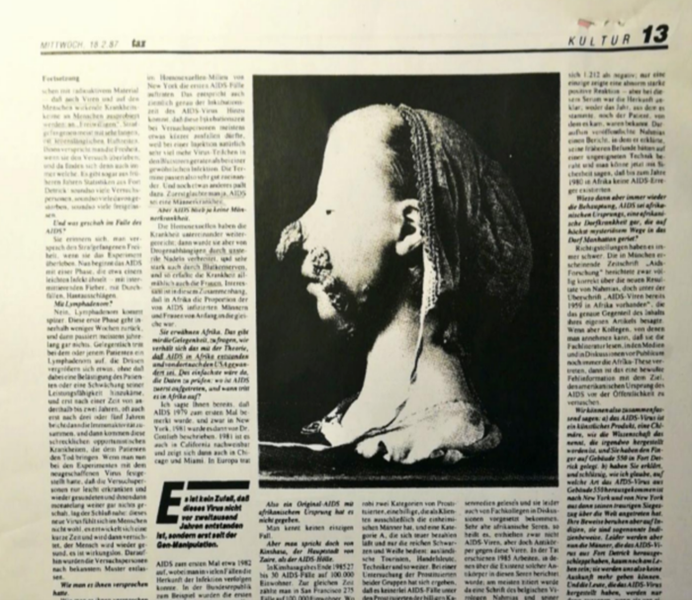
Fig. 10 taz, 18.02.1987

Fig. 11 Fra Filippo Lippi, Women’s portrait, about 1440
In summary, I would like to point out two obvious trends in working with visuals that have transnational universality and deep relevance for our understanding of how disinformation campaigns work today. Firstly, the authors of these publications do not try to find new pictorial solutions for visualizing a new biological phenomenon, striving, on the contrary, to embed this phenomenon in familiar, historically significant and well-recognized contexts; whether it be the iconography of the dance of death, the portrait canon of the Italian Renaissance or the Nazi threat of World War II. Secondly, there is an obvious divergence of linguistic and visual levels. While verbality strives for science, accuracy, and factography, the illustrative series, on the contrary, plays with feelings, provokes, and dispels the seriousness of tone. The informational message acquires the properties of artistic fiction, with its characteristic poetics and play of meanings. To fully appreciate how disinformation achieves its goals, it is not enough to study it verbally and in its relationship to facts. It must also be scrutinized visually, multi-modally and intertextually, and situated in its historical and societal contexts.
[i] The same cartoon decorated the cover of Douglas Selvage and Christopher Nehring’s Die Aids-Verschwörung. Das Ministerium für Staatssicherheit und die AIDS-Desinformationscampagne des KGB (Berlin: BStU, 2020).
[ii] See, for example, these US publications being cited in the Soviet newspaper, Literaturnaya gazeta, 7 May 1986.
[iii] It is possible that the context of this novel’s release also includes the famous Austrian poet and publicist Erich Fried’s publication "Die Waffe AIDS" in the Austrian weekly Wochenpresse on 13 March 1987.
[iv] The first printed message by Segal on this topic appeared in Zimbabwe in 1986: Jacob Segal and Lilli Segal, AIDS: USA- home made evil; NOT imported from AFRICA, a handout amended and assembled by unnamed African journalists for distribution in Harare, Zimbabwe, 1986.
[v] The article in Patriot is widely believed to be planted by the KGB.
[vi] Substitution of SPID (AIDS) for the first morpheme of spetsialisty (specialists)
[vii] In the tradition of a lubok, a popular folk print designed to enlighten and educate, the cartoon is headed by a complementary accompanying text, which explains in simple words that the virus was invented in Pentagon laboratories, while an important addition to the illustrative content is a link to "some Western scientists", as well as the attribution "from newspapers", blurring the specifics.